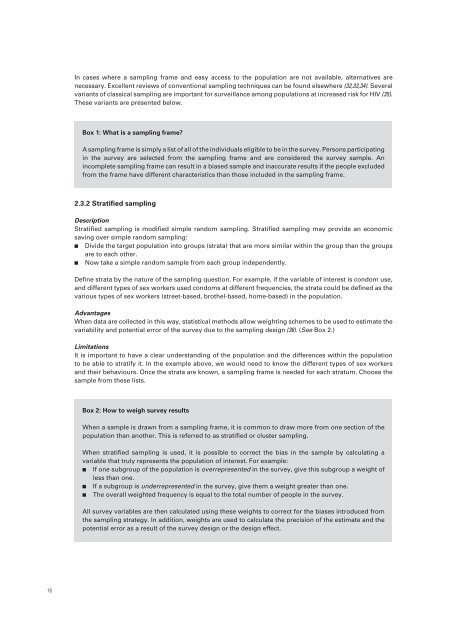Guidelines on surveillance among populations most at risk for HIV
Guidelines on surveillance among populations most at risk for HIV
Guidelines on surveillance among populations most at risk for HIV
- No tags were found...
Create successful ePaper yourself
Turn your PDF publications into a flip-book with our unique Google optimized e-Paper software.
In cases where a sampling frame and easy access to the popul<strong>at</strong>i<strong>on</strong> are not available, altern<strong>at</strong>ives arenecessary. Excellent reviews of c<strong>on</strong>venti<strong>on</strong>al sampling techniques can be found elsewhere (32,33,34). Severalvariants of classical sampling are important <strong>for</strong> <strong>surveillance</strong> am<strong>on</strong>g popul<strong>at</strong>i<strong>on</strong>s <strong>at</strong> increased <strong>risk</strong> <strong>for</strong> <strong>HIV</strong> (35).These variants are presented below.Box 1: Wh<strong>at</strong> is a sampling frame?A sampling frame is simply a list of all of the individuals eligible to be in the survey. Pers<strong>on</strong>s particip<strong>at</strong>ingin the survey are selected from the sampling frame and are c<strong>on</strong>sidered the survey sample. Anincomplete sampling frame can result in a biased sample and inaccur<strong>at</strong>e results if the people excludedfrom the frame have different characteristics than those included in the sampling frame.2.3.2 Str<strong>at</strong>ified samplingDescripti<strong>on</strong>Str<strong>at</strong>ified sampling is modified simple random sampling. Str<strong>at</strong>ified sampling may provide an ec<strong>on</strong>omicsaving over simple random sampling: Divide the target popul<strong>at</strong>i<strong>on</strong> into groups (str<strong>at</strong>a) th<strong>at</strong> are more similar within the group than the groupsare to each other. Now take a simple random sample from each group independently.Define str<strong>at</strong>a by the n<strong>at</strong>ure of the sampling questi<strong>on</strong>. For example, if the variable of interest is c<strong>on</strong>dom use,and different types of sex workers used c<strong>on</strong>doms <strong>at</strong> different frequencies, the str<strong>at</strong>a could be defined as thevarious types of sex workers (street-based, brothel-based, home-based) in the popul<strong>at</strong>i<strong>on</strong>.AdvantagesWhen d<strong>at</strong>a are collected in this way, st<strong>at</strong>istical methods allow weighting schemes to be used to estim<strong>at</strong>e thevariability and potential error of the survey due to the sampling design (36). (See Box 2.)Limit<strong>at</strong>i<strong>on</strong>sIt is important to have a clear understanding of the popul<strong>at</strong>i<strong>on</strong> and the differences within the popul<strong>at</strong>i<strong>on</strong>to be able to str<strong>at</strong>ify it. In the example above, we would need to know the different types of sex workersand their behaviours. Once the str<strong>at</strong>a are known, a sampling frame is needed <strong>for</strong> each str<strong>at</strong>um. Choose thesample from these lists.Box 2: How to weigh survey resultsWhen a sample is drawn from a sampling frame, it is comm<strong>on</strong> to draw more from <strong>on</strong>e secti<strong>on</strong> of thepopul<strong>at</strong>i<strong>on</strong> than another. This is referred to as str<strong>at</strong>ified or cluster sampling.When str<strong>at</strong>ified sampling is used, it is possible to correct the bias in the sample by calcul<strong>at</strong>ing avariable th<strong>at</strong> truly represents the popul<strong>at</strong>i<strong>on</strong> of interest. For example: If <strong>on</strong>e subgroup of the popul<strong>at</strong>i<strong>on</strong> is overrepresented in the survey, give this subgroup a weight ofless than <strong>on</strong>e. If a subgroup is underrepresented in the survey, give them a weight gre<strong>at</strong>er than <strong>on</strong>e. The overall weighted frequency is equal to the total number of people in the survey.All survey variables are then calcul<strong>at</strong>ed using these weights to correct <strong>for</strong> the biases introduced fromthe sampling str<strong>at</strong>egy. In additi<strong>on</strong>, weights are used to calcul<strong>at</strong>e the precisi<strong>on</strong> of the estim<strong>at</strong>e and thepotential error as a result of the survey design or the design effect.16















